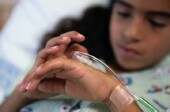- Tips for Spending Holiday Time With Family Members Who Live with Dementia
- Tainted Cucumbers Now Linked to 100 Salmonella Cases in 23 States
- Check Your Pantry, Lay’s Classic Potato Chips Recalled Due to Milk Allergy Risk
- Norovirus Sickens Hundreds on Three Cruise Ships: CDC
- Not Just Blabber: What Baby’s First Vocalizations and Coos Can Tell Us
- What’s the Link Between Memory Problems and Sexism?
- Supreme Court to Decide on South Carolina’s Bid to Cut Funding for Planned Parenthood
- Antibiotics Do Not Increase Risks for Cognitive Decline, Dementia in Older Adults, New Data Says
- A New Way to Treat Sjögren’s Disease? Researchers Are Hopeful
- Some Abortion Pill Users Surprised By Pain, Study Says
More Drug-Resistant Infections Seen in U.S. Children


A growing number of American children are developing infections caused by a worrisome type of antibiotic-resistant bacteria, a new study report.
While still rare, the bacteria are being found more often in children of all ages, especially those who are 1 to 5 years old, the study found.
Investigators analyzed samples collected from children nationwide between 1999 and 2011 to assess the prevalence of the antibiotic-resistant type of bacteria called Enterobacteriaceae, which produces an enzyme called extended-spectrum beta lactamase (ESBL).
The enzyme defeats many strong antibiotics, the study authors said.
The researchers also measured ESBL prevalence by looking at rates of resistance to third-generation cephalosporins, which are an important class of antibiotics used to treat many infections.
The prevalence of ESBL-producing bacteria rose from 0.28 percent in 1999 to 0.92 percent in 2011. And resistance to third-generation cephalosporins climbed from 1.4 percent to 3 percent, the study found.
ESBL-producing bacteria were found in children of all ages nationwide, but slightly more than half were found in youngsters 1 to 5 years old. About 74 percent of these bacteria were resistant to many types of antibiotics.
The study appears online March 20 in the Journal of the Pediatric Infectious Diseases Society.
“These antibiotic-resistant bacteria have traditionally been found in health care settings but are increasingly being found in the community, in people who have not had a significant history of health care exposure,” study author Dr. Latania Logan, of Rush University Medical Center in Chicago, said in a journal news release.
The rate of these infections in children is still low, but ESBL-producing bacteria can spread rapidly, Logan and colleagues noted.
They added that these bacteria have been linked to longer hospital stays, increased risk of death and higher health care costs.
When treating children with suspected bacterial infections, doctors should obtain cultures to determine which antibiotics would be most effective, the researchers said.
“Some infections in children that have typically been treated with oral antibiotics in the past may now require hospitalization, treatment with intravenous drugs, or both, as there may not be an oral option available,” the study authors concluded.
More information
The U.S. Centers for Disease Control and Prevention has more about antibiotic resistance.
Source: HealthDay
Copyright © 2024 HealthDay. All rights reserved.










